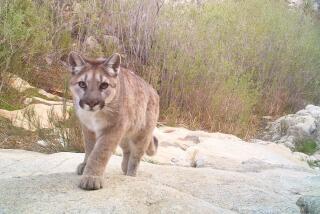Rat poison kills bobcat, mountain lion in Southern California mountains
A young mountain lion and an adult bobcat whose bodies were found earlier this year in Southern California both died from rat poisons, the latest wildlife fatalities linked to the pest control compounds, officials announced Thursday.
While mountain lions periodically succumb to the poisons, this is only the second time in a 24-year study period that a bobcat has died directly from the effects of anticoagulant rodenticides, according to the Santa Monica Mountains National Recreation Area.
The last such death was 23 years ago.
“We basically never see this in bobcats, so this is an important finding,” Joanne Moriarty, a biologist who works on bobcat research, said in a statement.
The bobcat that died, an adult female known as B-372, was originally captured and collared Jan. 28 in southern Cheeseboro Canyon, north of the 101 Freeway.
Her body was found June 20 under an oak tree in an Agoura Hills neighborhood, officials said. A necropsy later found several toxic compounds in her system: brodifacoum, bromadiolone and diphacinone.
All are used as anticoagulant rodenticides, designed to kill rodents by thinning their blood and preventing clotting, which leads to uncontrollable bleeding.
Predators can ingest those poisons when they feed on the vermin.
Officials said virtually all bobcats in the study — more than 90% — test positive for exposure to such compounds after death. However, biologists say they generally do not see internal bleeding in the cats, which would indicate they died as a direct result of poison exposure.
Bobcats far more often die from disease, namely mange, or being hit by a car, officials said.
At least six bobcats have been struck and killed by vehicles in the Santa Monica Mountains in the past three months, including one that had been captured and collared by wildlife officials shortly before the Woolsey fire, the National Park Service said.
B-372 was extremely emaciated and showed signs of chronic anemia, officials said, meaning she may have been exposed to rat poisons repeatedly.
Moriarty said this particular cat spent a good deal of time in residential areas. Large parts of the animal’s nearby natural habitat were charred in the 2018 Woolsey fire.
“We documented several other collared bobcats abandoning burned areas in the Simi Hills shortly after the fire,” officials from the Santa Monica Mountains National Recreation Area wrote in a statement.
“Spending more time in neighborhoods may have led to increased exposure to the poisons often used by homeowners or businesses to control rodents. More exposure, potentially over a shorter time period, could have led to more severe direct impacts of the toxicants than we normally see in this species.”
P-30 and P-53, which had previously been treated for mange, were found dead in September and August, respectively.
Mountain lions, on the other hand, have more regularly fallen prey to poison.
The latest, a younger male called P-76, was the third collared cougar to die of coagulopathy — uncontrolled bleeding — in the last two years and the sixth overall, according to the National Park Service.
NPS researchers have been studying wild carnivores in and around the Santa Monica Mountains for more than two decades, and mountain lions in particular since 2002.
Officers from the California Department of Fish and Wildlife captured and collared P-76 in Northridge last November.
His body was found Jan. 30 in the Santa Susana Mountains north of Highway 118. The results of a necropsy, which came back only recently, showed he had been exposed to five compounds: the same three as B-372, plus chlorophacinone and difethialone.
“These two cases show us that different non-target species are continuing to be exposed to these toxicants, including an array of different poisons, with effects up to and including death from uncontrolled bleeding,” Seth Riley, wildlife branch chief for the Santa Monica Mountains National Recreation Area, said in a statement.
“We are also continuing to see lots of cases of severe mange disease in bobcats in the area. Between poisons, disease and the massive Woolsey Fire, it has been a tough go recently for our wild cats in the park.”
More to Read
Start your day right
Sign up for Essential California for news, features and recommendations from the L.A. Times and beyond in your inbox six days a week.
You may occasionally receive promotional content from the Los Angeles Times.







